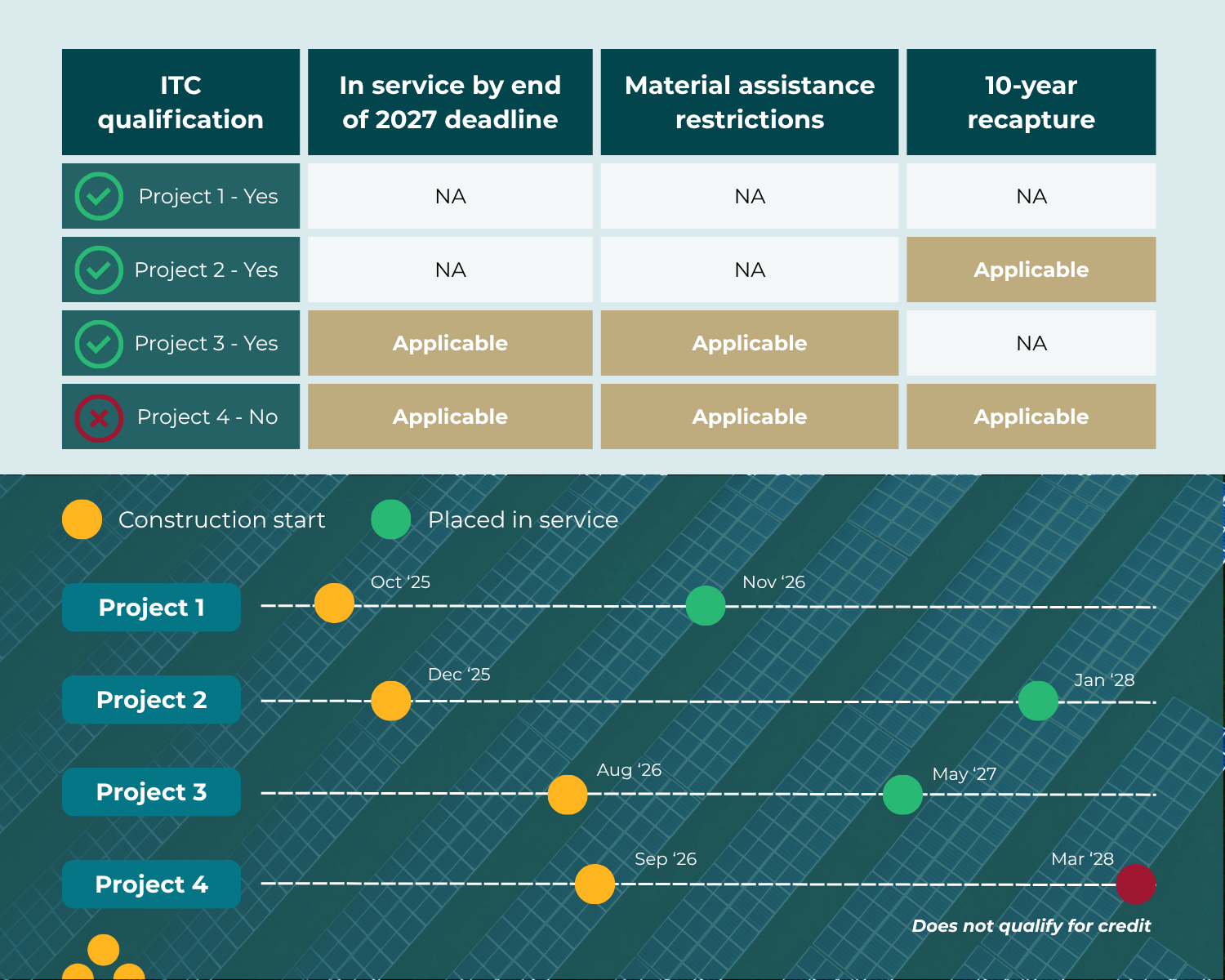July 25, 2025
Strategic energy implications of the phaseout of Section 48E for wind & solar credits
The One Big Beautiful Bill Act (OBBBA), signed into law on July 4th 2025, is not entirely the clean energy apocalypse that many predicted. Though the bill introduced an early phaseout of the Sec48E credits for wind and solar, it maintained the credit for other technologies, like battery storage, nuclear, and geothermal. It also preserved tax credit transferability, which will support significant clean energy financing over the next decade. While companies seeking to deploy solar and wind assets in the United States with the help of tax equity financing face compressed timelines and new constraints, pathways to execute still exist.
Energy availability and business continuity in the face of the OBBBA
Despite policy upheaval, fundamental market forces make onsite solar generation more critical than ever. AI and data centers are driving electricity demand at a record pace – the Department of Energy (DOE) warns blackouts could increase 100X by 2030 without adequate generation capacity.
In addition to increased demand from AI and data centers, manufacturing reshoring, equipment electrification, and climate-driven cooling add pressure to the already strained grid – the DOE forecasts a 15% peak demand increase by 2030. Distributed solar offers essential resilience and independence from an increasingly stressed grid.
Staying strategic through macro uncertainty
Overcoming the challenges introduced by the OBBBA means going beyond traditional project development approaches. The speed of policy change and scale of capital deployment requires deep analysis.
To transform ambiguity into strategic advantage, organizations will need to combine advanced energy modeling, return on carbon (cost per metric ton of CO2 reduced) metrics, real-time policy tracking, and geospatial analytics.
Only through the integration of these different considerations will companies be able to identify which projects are worth accelerating to meet OBBBA deadlines based on resilience, decarbonization, and business growth needs.
Navigating wind & solar requirements of the OBBBA
Moving forward, companies will need to define strategies around where to accelerate their wind and solar pipelines and how to navigate new requirements introduced by the bill, including:
- Solar and wind projects must begin construction by July 3, 2026, in order to qualify for Section 48E with no limitation on the placed-in-service date.
- Projects that begin construction after July 3, 2026, must be placed in service by December 31, 2027, to qualify.
- Foreign Entity of Concern (FEOC) restrictions precluding a taxpayer from being a Prohibited Foreign Entity go into effect for taxable years after July 4, 2025.
- Foreign Entity of Concern (FEOC) restrictions pertaining to material assistance from a prohibited foreign entity go into effect for projects that begin construction after December 31, 2025.
- For tax credits claimed in tax years starting more than 2 years after 7/4/25, the full credit must be repaid to the IRS if the taxpayer makes payments under contracts or technology licenses that give a specified foreign entity (SFE) effective control. Any payment from the taxpayer to an SFE during the 10 years after a project is placed in service would trigger a recapture.
- The Executive Order, Ending Market Distorting Subsidies for Unreliable, Foreign Controlled Energy Sources, released on July 7, 2025, introduces further uncertainty by directing the IRS to update beginning-of-construction requirements.
Strategy in action: Scenarios for project eligibility
As an example of how companies might face these restrictions and uncertainty, a company prioritizing upcoming solar projects would need to review their pipeline for the applicability of the various exclusions. The table below outlines how these exclusions apply to projects given their beginning of construction and placed in service dates.
Note: Projects are typically considered to be placed in service when they are ready and available for use, regardless of whether they are actually used. “Applicable” in the table below refers to the ITC provision element which is applicable to a given project.

Outlook for energy security and resilience
Although the OBBBA is projected to sizably reduce clean energy capacity buildout in the United States over the next 10 years, it is not a wholesale repeal of the Inflation Reduction Act. The credits it maintains for technologies like energy storage, geothermal, and nuclear are important levers for energy resilience and security strategies. Energy storage in particular, both integrated into generation projects and as standalone assets, are critical for cost-conscious organizations focused on building resilience.
Businesses need a diverse portfolio of energy solutions to maintain operational resilience in an electricity-constrained future. New solar and wind power, currently the cheapest and most quickly scalable energy sources, are critical components of that portfolio. And despite the regulatory headwinds for Section 48E wind and solar credits, solutions do still exist to scale these technologies.
To hear more about how Earth Finance helps organizations manage energy resilience project pipelines and tap innovative financing mechanisms, get in touch with us below, or reach out directly to Energy Security experts Garrett Kephart or Chase Kania.





